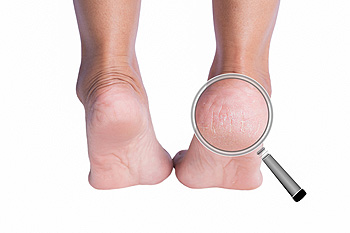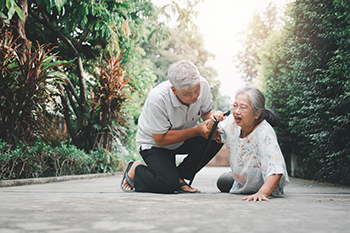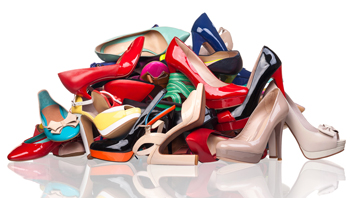Items filtered by date: November 2022
Cracked Heels and Socks

Although many cases of cracked heels are not necessarily severe and painful, the condition can nonetheless be an annoyance and potentially uncomfortable. The condition is defined as a lack of moisture on the back of the heels that causes the skin to crack and fissure. There are many ways in which cracked heels might be prevented. Socks might play an important role in achieving this end. For example, to prevent the heels from becoming dry, an individual could generously apply moisturizer to the feet at night before bed and put on a pair of socks. The socks can essentially lock in the moisturizer and help improve the extent to which the moisturizer is absorbed by the feet. If you are worried about cracked heels and want to learn more preventative methods, contact a podiatrist today. This foot specialist can help you address any problems you might have.
Cracked heels are unsightly and can cause further damage to your shoes and feet. If you have any concerns, contact Dr. John Branwell from Kearny, New Jersey. Our doctor can provide the care you need to keep you pain-free and on your feet.
Cracked Heels
Cracked heels appear unappealing and can make it harder for you walk around in sandals. Aside from looking unpleasant, cracked heels can also tear stockings, socks, and wear out your shoes. There are several methods to help restore a cracked heel and prevent further damage.
How Do You Get Them?
Dry skin is the number one culprit in creating cracked heels. Many athletes, walkers, joggers, and even swimmers suffer from cracked heels. Age and skin oil production play a role to getting cracked heels as well.
Promote Healing
Over the counter medicines can help, especially for those that need instant relief or who suffer from chronic dry feet.
Wear Socks – Wearing socks with medicated creams helps lock in moisture.
Moisturizers – Applying both day and night will help alleviate dryness which causes cracking.
Pumice Stones – These exfoliate and remove dead skin, which allows for smoother moisturizer application and better absorption into the skin.
Change in Diet
Eating healthy with a well-balanced diet will give the skin a fresh and radiant look. Your body responds to the kinds of food you ingest. Omega-3 fatty acids and zinc supplements can also revitalize skin tissue.
Most importantly, seek professional help if unsure how to proceed in treating cracked heels. A podiatrist will help you with any questions or information needed.
If you have any questions, please feel free to contact our office located in Kearny, NJ . We offer the newest diagnostic and treatment technologies for all your foot care needs.
Risks of Falling Among Seniors

As one ages, the repercussions of falling increase. Studies show that people over 65 years old fall at least once a year. Further, one out of five falls results in serious injury. It is commonly held that safety proofing in the home is essential in preventing falls. Other experts agree that keeping a positive attitude and not being afraid of falling is just as important. One of the main recommendations is to have a plan in place in case you do fall. Some people use medical alert devices or carry a phone with them at all times. Practice getting up from the floor in order to be more prepared if you should take a tumble. Changing the way you handle problems is another way to prevent falls. For instance, ask for help rather than get on a ladder to reach a top shelf. Removing hazards, such as loose wiring and scatter rugs from your home is also recommended. Have walking aids available for times when you feel less sure on your feet. Balance and strength exercises are a good way to keep your legs and feet under you. See a podiatrist for more information on ways to prevent falling.
Preventing falls among the elderly is very important. If you are older and have fallen or fear that you are prone to falling, consult with Dr. John Branwell from Kearny, New Jersey. Our doctor will assess your condition and provide you with quality advice and care.
Every 11 seconds, an elderly American is being treated in an emergency room for a fall related injury. Falls are the leading cause of head and hip injuries for those 65 and older. Due to decreases in strength, balance, senses, and lack of awareness, elderly persons are very susceptible to falling. Thankfully, there are a number of things older persons can do to prevent falls.
How to Prevent Falls
Some effective methods that older persons can do to prevent falls include:
- Enrolling in strength and balance exercise program to increase balance and strength
- Periodically having your sight and hearing checked
- Discuss any medications you have with a doctor to see if it increases the risk of falling
- Clearing the house of falling hazards and installing devices like grab bars and railings
- Utilizing a walker or cane
- Wearing shoes that provide good support and cushioning
- Talking to family members about falling and increasing awareness
Falling can be a traumatic and embarrassing experience for elderly persons; this can make them less willing to leave the house, and less willing to talk to someone about their fears of falling. Doing such things, however, will increase the likelihood of tripping or losing one’s balance. Knowing the causes of falling and how to prevent them is the best way to mitigate the risk of serious injury.
If you have any questions, please feel free to contact our office located in Kearny, NJ . We offer the newest diagnostic and treatment technologies for all your foot care needs.
Arthritis Can Cause Pain in the Feet and Ankles
What Are Corn Pads?

Corns of the feet can develop when a specific area of the foot is exposed to a significant amount of pressure or friction. Corns, thickened areas of skin, grow in response. There are many steps that an individual might consider taking to mitigate the effect that corns can have on the health of their feet. One mitigation technique to reduce discomfort from corns is known as corn pads. These pads are shaped like a doughnut and are meant to be adhered to the affected area, with the corn in the center hole. These corn pads are typically made of various materials, including foam and moleskin. Contact a podiatrist today for more information about how corn pads can help you.
If you have any concerns regarding your feet and ankles, contact Dr. John Branwell of Kearny, New Jersey. Our doctor will treat your foot and ankle needs.
Corns: What Are They? and How Do You Get Rid of Them?
Corns can be described as areas of the skin that have thickened to the point of becoming painful or irritating. They are often layers and layers of the skin that have become dry and rough, and are normally smaller than calluses.
Ways to Prevent Corns
There are many ways to get rid of painful corns such as wearing:
- Well-fitting socks
- Comfortable shoes that are not tight around your foot
- Shoes that offer support
Treating Corns
Treatment of corns involves removing the dead skin that has built up in the specific area of the foot. Consult with Our doctor to determine the best treatment option for your case of corns.
If you have any questions please feel free to contact our office located in Kearny, NJ . We offer the newest diagnostic and treatment technologies for all your foot and ankle needs.
The Relationship Between Gout and Certain Foods

Gout is a foot affliction that is a certain kind of arthritis. As a result of gout, an individual can feel painful sensations in their feet. Gout attacks, as they are known, are flare-ups that can occur in the nighttime. Importantly, gout has a relationship to certain kinds of food. For example, an individual living with gout can exacerbate their condition by ingesting red meat and pork. This is because such foods are very high in purines. An increase in purines in the body is typically associated with an increase in uric acid. This uric acid then accumulates in the joints, causing gout. Therefore, to avoid gout attacks, an individual should maintain a diet that has a low amount of purine-high foods. Consult a podiatrist today if you think that you have gout or want to learn how to manage the condition.
Gout is a foot condition that requires certain treatment and care. If you are seeking treatment, contact Dr. John Branwell from Kearny, New Jersey. Our doctor will treat your foot and ankle needs.
What Is Gout?
Gout is a type of arthritis caused by a buildup of uric acid in the bloodstream. It often develops in the foot, especially the big toe area, although it can manifest in other parts of the body as well. Gout can make walking and standing very painful and is especially common in diabetics and the obese.
People typically get gout because of a poor diet. Genetic predisposition is also a factor. The children of parents who have had gout frequently have a chance of developing it themselves.
Gout can easily be identified by redness and inflammation of the big toe and the surrounding areas of the foot. Other symptoms include extreme fatigue, joint pain, and running high fevers. Sometimes corticosteroid drugs can be prescribed to treat gout, but the best way to combat this disease is to get more exercise and eat a better diet.
If you have any questions please feel free to contact our office located in Kearny, NJ . We offer the newest diagnostic and treatment technologies for all your foot and ankle needs.
Are People Still Wearing High Heels?

High Heel sales dropped 71% in 2020, according to fashion trends, and it is unclear whether they will ever increase or whether we even want to wear them as much anymore. The pandemic and associated shutdowns curtailed fancy dressing and going out. Many women relied on athletic shoes and flats during this time. It is uncertain of what will happen in the future, but we know that more people are working from home now and high heel sales started to decline before the pandemic. Business casual took on new meaning with younger professionals who wore trendy high-tops, clogs, and Uggs to work. Streetwear became high fashion, and there were shifts in what was appropriate attire for an office. Comfort is in. People are also at their best when they look it and feel it. Frequently wearing high heels can cause foot issues and younger people are less willing to feel foot pain. It is beneficial that fashion is changing and wearing them only for special occasions may be on the rise. If you want to learn more about how to properly care for your feet to get you through a lifetime of changing footwear trends, please consult with a podiatrist.
High heels have a history of causing foot and ankle problems. If you have any concerns about your feet or ankles, contact Dr. John Branwell from Kearny, New Jersey. Our doctor can provide the care you need to keep you pain-free and on your feet.
Effects of High Heels on the Feet
High heels are popular shoes among women because of their many styles and societal appeal. Despite this, high heels can still cause many health problems if worn too frequently.
Which Parts of My Body Will Be Affected by High Heels?
- Ankle Joints
- Achilles Tendon – May shorten and stiffen with prolonged wear
- Balls of the Feet
- Knees – Heels cause the knees to bend constantly, creating stress on them
- Back – They decrease the spine’s ability to absorb shock, which may lead to back pain. The vertebrae of the lower back may compress.
What Kinds of Foot Problems Can Develop from Wearing High Heels?
- Corns
- Calluses
- Hammertoe
- Bunions
- Morton’s Neuroma
- Plantar Fasciitis
How Can I Still Wear High Heels and Maintain Foot Health?
If you want to wear high heeled shoes, make sure that you are not wearing them every day, as this will help prevent long term physical problems. Try wearing thicker heels as opposed to stilettos to distribute weight more evenly across the feet. Always make sure you are wearing the proper shoes for the right occasion, such as sneakers for exercising. If you walk to work, try carrying your heels with you and changing into them once you arrive at work. Adding inserts to your heels can help cushion your feet and absorb shock. Full foot inserts or metatarsal pads are available.
If you have any questions please feel free to contact our office located in Kearny, NJ . We offer the newest diagnostic and treatment technologies for all your foot and ankle needs.

